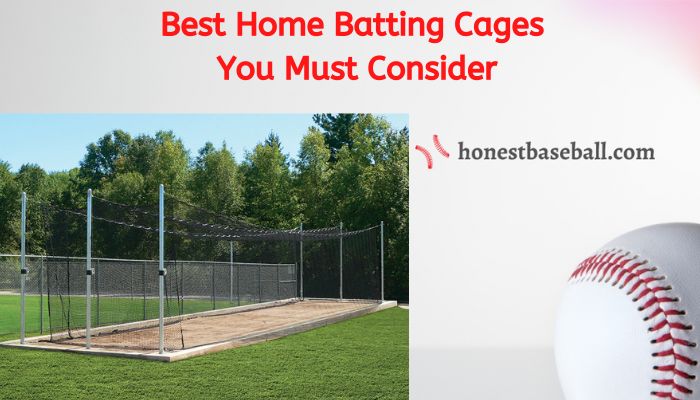There are tools that help people to reach their destination with the help of them. In baseball and softball, a batter needs a lot of practice hitting to become a great batter. And for that best home batting cage can be the best solution in today’s world.
Backyard batting cages are one of the best catalysts for a batter to improve his ability and capability.
The best backyard batting cages should pass many requirements. They include pricing, size, spacing, good materials, frame, and net types, temporary or permanent structure, indoor, or outdoor setup, etc.
Let’s clarify the things and let me help you to get the best backyard batting cages from our top 5 picks. At the end of the post, I will recommend the 5 best batting cages that would fulfill your batting practice demand in a crafted way.
Do I Need A Backyard Batting Cage?

Hitting a baseball is difficult beyond the thinking of observers and spectators. It’s never been that easy, many people think.
But, players must hit the ball if they want to become a hitter. Ultimately, continuous practice can ensure that you could be able to hit the ball if you keep the practice on.
As a result, professional players never stop practicing hitting at all. So, you must ensure your children do the same to make sure their muscles are accustomed to the mechanics of batting swings.
You have different options for your child to practice batting.
You may prefer to practice on a baseball field. This gives you or your child a feel of the real game. But, you have to collect all batted balls on your own in the end.
Another good option is using commercial batting cages. A commercial batting cage frame is made of expensive materials. Also, the pitching machines used here throw balls with a minimum of 45 mph.
You should not go for this if your child is under 10 years old. Instead, you can check out baseball drills for 10 years old kid.
Also, a local field with batting cages is another great option if they are available to do the practice. But, the irony is, you will find most batting cages filled with hitters. You never know when they will be available for you or your kids.
Think, you go to the local field for the hitting cage and wait until the sunset, but don’t have the chance by this to get into the cage. This is bothering no doubt.
But, in case of having your own backyard batting cage nets would be great and reliable to get into anytime. There is no restriction and waiting mode. As a result, this will save your time and give you plenty of time to practice your hitting cage.
In my case, I have been happily doing the stuff for batting practice for my kids in my in-house backyard batting cage and doing some extra stretching and other exercises.
This saves me a lot of time for my kids and allows them hundreds of swings daily. There is no hurry, restriction, confusion, or uncertainty to get to the hitting cage.
By the way, you can choose any type of home batting cage based on your space and budget.
Younger players who just started might want to play baseball well. If they get the instruction from a coach, it would be nice. Let’s see how to play baseball explained by a coach.
The Basic Dimension of Backyard Batting Cages
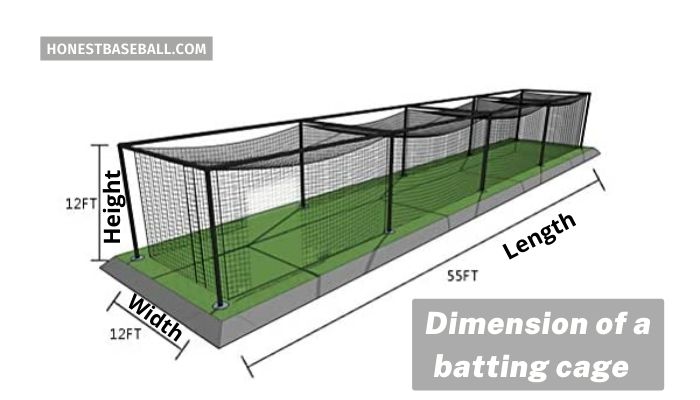
Batting cage dimension is one of the essential aspects regarding the size of the batting cages. A batting cage could be bigger or smaller, based on the types of baseball players.
So, first, consider which level of player will use the cage. For professional baseball players, the residential batting cage should be long enough. This also should be wider and taller.
On the other hand, amateur players would be ok with comparatively smaller batting cages. By the way, let me give an overview of the basic dimension of a batting cage to understand its nominal size.
Length
Most batting cages are 70 feet long. Most baseball players and parents choose this size batting cage for their kids. But, the batting cage size could be as small as 20 feet to as big as 80 feet.
The 70 feet longer batting cages are reliable to give enough room between the batter and the pitcher (or pitching machines). This also ensures the real distance from the home plate to the pitching mound.
Also, the standard 70 feet length helps easily fit all necessary equipment for batting including batter’s boxes, pitching mound, pitching machine, etc.
By the way, youth players could consider the length of the batting cages ranges from 30 feet to 40 feet. Intermediate players can go for 50 to 60 feet.
On the other hand, collegiate and professional players can go off with 70 feet to 80 feet long batting cages.
Pitching machines help to practice batting without a live pitcher. But do you know its consequences? You will find the answer on the guide on Are Pitching Machines Good For Batting Practice?
Height
More height of the batting cages gives more room to properly analyze the balls that come to the batter from the pitcher or the pitching machine. More height helps to analyze the speed of the ball and its spins.
By the way, the basic and mostly used height of backyard batting cages is 12 feet.
However, the taller height is not the optimal margin for choosing the cages’ height. You also should check for overflow netting.
You’ll need about a foot of sagging netting on the floor to catch balls as they fly around the cage. In many cases, for amateur players, a height of 8 to 9 feet is enough. As I have mentioned, the cage’s length depends on the players’ level; the height is the same to consider for wingspan.
But remember, the smaller cages end the impact of the hitting more quickly than the taller cages.
Width
Another critical factor to take into account is the cage’s breadth. The standard and most widely used width variation for backyard batting cages are 12 to 14 feet.
By the way, younger players tend to benefit more from the narrower breadth. Younger, less experienced, and players under the height of 6 feet tend to choose 12 feet wide batting cage netting.
The preference of collegiate and professional athletes is for batting cages that are 14 feet wide. By the way, depending on the batter’s reach, the tunnel’s width would change. Another factor that affects the width of the batting cage is the length of the bat.
Another crucial consideration is that you must select bigger cage netting if you employ a pitching machine in the cage.
Pitching is another most important rule in baseball. If you are looking to develop your pitching accuracy, the guide on Pitching Drills For Accuracy by a professional could significantly help you.
Batting Cages Buying Guide: Things to Consider While Buying Backyard Batting Cages
Buying something for essential work always demands precise consideration for many aspects. When you want a durable net with the best batting cages, you just consider some unavoidable entities to ensure you get the best batting cage per your requirements.
Let’s check out the things to consider for getting the perfect home batting cages.
Pricing
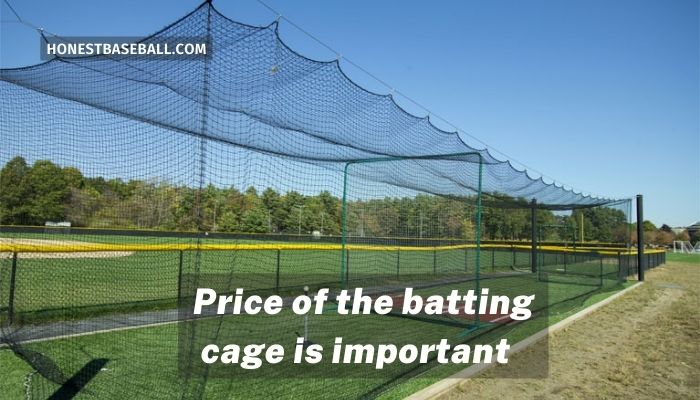
Pricing is always the main aspect whenever you want to buy something. Pricier cages are expected to be more sturdy, durable, weather-proof, and so on.
But, you cannot always spend a lot. In this case, you must choose the best reliable option with the minimum price you can afford.
By the way, a smaller cage is always cheaper than a bigger one. If you don’t need a bigger cage, you save significant money by purchasing a smaller one.
Required Space to Place the Baseball Batting Cage
Before choosing the size of the batting cage, you must measure the space in your backyard. You should select the size of the cage based on your yard.
Also, make sure you have allowed a particular amount of extra space so that you can room for setting up the cage easily. Also, ensure you have enough distance between the normal walkway and the cage.
Batting Cage Material for Frame
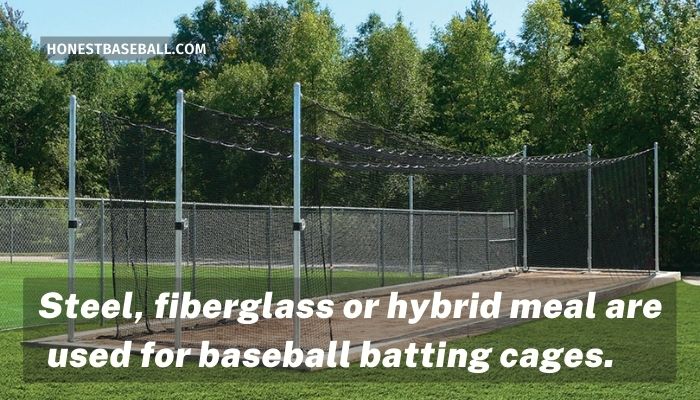
Batting cage materials are the core element to consider. A batting case is comprised of two basic parts: frame and net. You may find the frame of the batting cages in different shapes, designs, and sizes.
But the durability and sturdiness vary depending on the materials of the frames. Basically, three primary frame materials are used in making the baseball batting cages: fiberglass frames, fiberglass with steel rods, and steel frames.
Whereas fiberglass frames are less durable and cheaper than steel frames. You should pick the right one based on your needs.
Types of Nets
The batting cage nets come in different materials: Poly twine and nylon. Poly twine is water resistant and preferred for use in outdoor weather including sun, rain, and wind.
On the other hand, nylon is preferred for indoor batting cages, and they are stronger than polyethylene. It has a greater shock absorbing capability than poly twine, bringing more durability to the netting.
By the way, there are many options available for netting when you go for them. The most commonly used three nettings are 24-netting, 36-netting, and 42-netting.
#24 Netting Poly twine
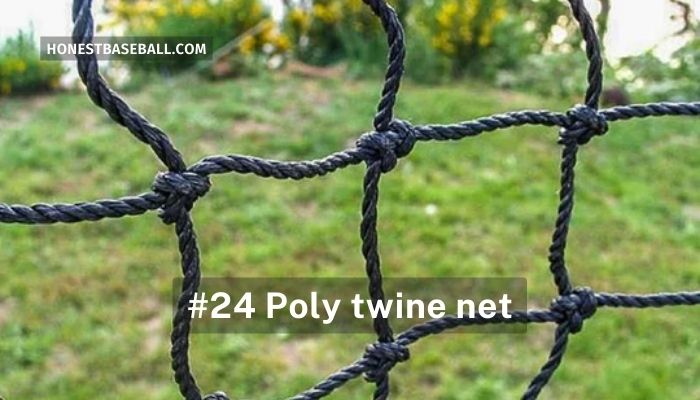
Basically preferred for residential batting cages and young players. 24 netting is made of poly twine and can withstand rainy conditions for 3 to 5 years. By the way, it is not ideal for severe conditions and for experienced and professional players.
#36 Netting Poly twine
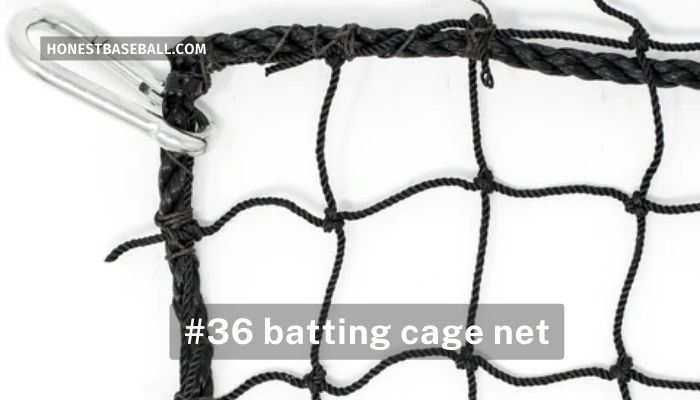
The 36 netting is a light-grade commercial netting. And in most cases, it withstands all types of players including young to moderate levels. Also, the 36 netting is thicker than 24-netting which ensures more durability than the 24.
It is durable and could last up to 5 years based on the players’ type and level of playing. It is ok with multiple hitters as well. Also, it could pass most weather conditions with perfect performance.
We can not guarantee it, but it is the most popular netting material so far.
#42 Netting nylon nets
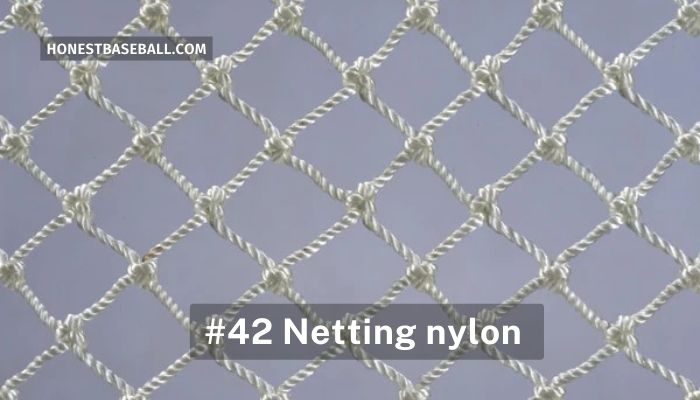
The thickest and most durable netting of the three is 42 netting. It is also the most resilient and can endure the strongest blows. Strong and seasoned hitters are likely to choose this one.
The 42 netting has a 5-year minimum lifetime. But in most situations, you may anticipate more than 5 years. The heavy-duty industrial batting cage netting material can resist players of all skill levels.
Additionally, it can handle the strongest line drives in all weather.
Indoor Batting Cages or Outdoor Batting Cages
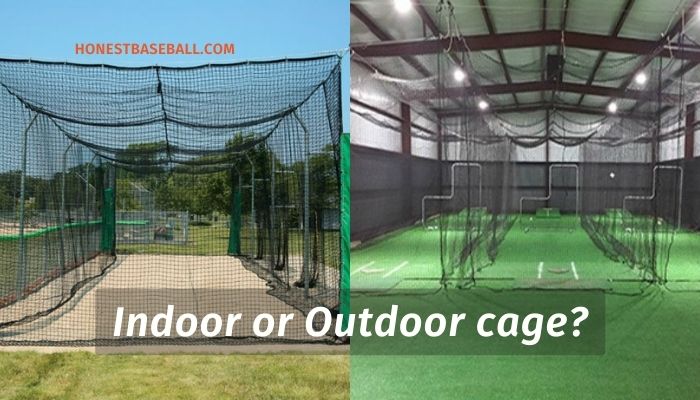
The majority of batting cages may be used both inside and outside. Some of them are specifically made for use inside or outside. In this situation, be confident of your needs and measure the area accordingly.
Ensure enough room for the inside cages to move around easily. To prevent mishaps of any kind, be cautious of any lights.
Batting practice in an indoor batting cage:
Temporary Batting Cages or Permanent Cages
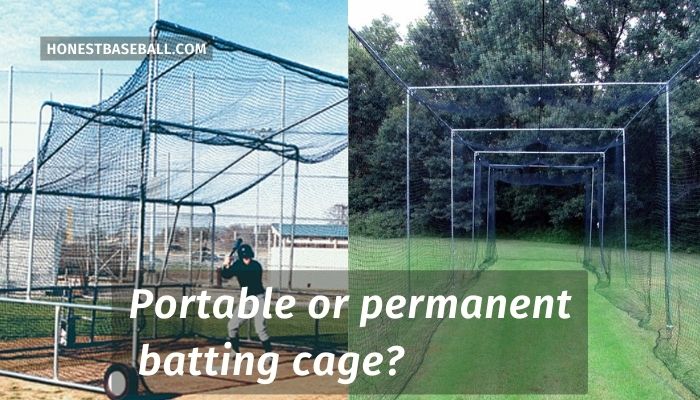
Batting cage portability is a big concern for the batting cages. Portable batting cages are a great option when it comes to space. You can just fold and keep your portable cage netting after baseball practice.
This will save the space of your lawn or yard. If you have a shortage of space but want to go for a larger net, you should go for the temporary batting cages.
Also, they are easy to set up, with the advantages of the fiberglass frame design. This also helps you to skip the hassles of a permanent cage setup.
But, there is a fundamental problem with the temporary batting cages. Their structure is the main problem when it comes to durability.
Most of the temporary batting cages do not withstand inimical weather. Basically, heavy wind can destroy them even with the highest level of security.
On the other hand, wind or cold weather is not that concerning for the permanent hitting net. So, it is important to consider your area’s weather and decide whether you take the portable cage netting or permanent cage netting.
If the temporary batting cages are on your choice list, you should go for fiberglass or residential steel frames. Fiberglass batting cages are easy to set up and remove, likely to need 15 to 20 minutes.
On the other hand, temporary residential batting cages take about 1 hour or some more to set up.
On the other hand, a permanent structure takes a long time to set up. The commercial batting cage frames are cemented into the ground stakes. Generally, the permanent batting cage takes at least two days to set up.
One day for setting up the support poles permanently. You need to wait for a day-long to cure the cement. Then set up the rest of the frame and nets.
But remember, you are getting a permanent part of your yard by installing the permanent batting cages in your yard.
But, it is true that the permanent structure will be going to give you a tough structure that will withstand inimical weather by all means.
Pitching Machine Setup Place
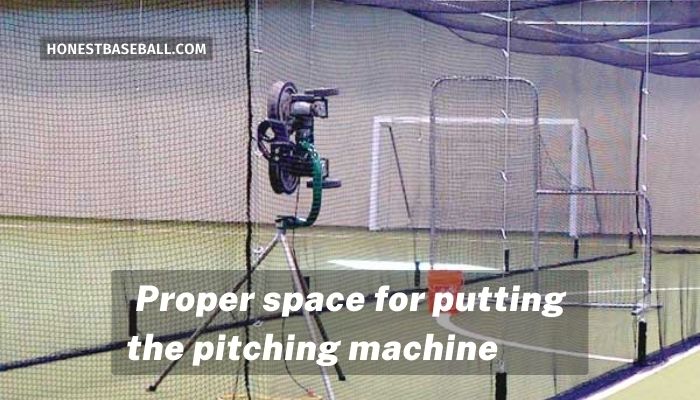
Setting up the pitching machines or standing the pitcher is another concern while setting up the batting cage. Because the machine or the pitcher will pitch the ball to hit by hitters.
As a result, you must figure out where to place your pitching machine harness. It is most important to save the pitcher or the pitching machine from the batted balls.
An effective solution to protect the pitching machine from batted ball flight tracking inside the batting cages is to use a pitching machine screen. An L-screen could be the specific choice to save the pitcher or the pitching machine.
Some companies feature a batting cage and pitching machine combo with holes on the back of the cage to set the pitching machine and shoot the balls. As a result, the pitching machine sits outside of the cage nets. This protects the machine from the line drives.
By the way, a batter should stand at least 3 feet away from the batting side to properly back swing his bat. Also, if the pitching machine is inside the batting cage, it should be at least 2 feet away from the net.
That is why a 66 to 70-long batting cage is ideal for enough room to move. This helps to simulate the 60 feet distance between the batter and the pitching machine which gives the real game distance on the baseball field.
The Way You Setup the Batting Cage Nets
The way to set up a batting cage is one the important fact. Because the setup process is easy, you will not get hassles with it. This will save you money, time, and hard work.
By the way, most portable and permanent cages come with an instruction guide. They show step-by-step processes o how to set up the batting cages.
As I mentioned, the most reliable ones may take 15 to 20 minutes. The complicated ones may take more than hours. All depend on the structure design and construction.
On the other hand, permanent cages need different ways of setting them up. You need to cement them into the ground. After cementing the frame and curing them, you need to pull the netting material over the frame.
By the way, take the reliable one you determine.
What Are the Materials Used for Batting Cage Frames?
Baseball batting cages are mainly made of two materials: fiberglass frames and steel frames. Aside from these, a combination of fiberglass and steel rods is also found.
The sturdiness depends on the age group and level of players. The younger players are ok with the fiberglass frames. On the other hand, more sturdiness is required for the experienced and older players.
Fiberglass Batting Cage Frame
The least resistant type of netting is made of fiberglass frames. Additionally, it is economical. Long-term damage from repeated severe pounding might result in the breakage of fiberglass frames.
The winter season, on the other hand, is the harshest weather for fiberglass frames. In many situations, this results in fractures in most frames.
However, a fiberglass frame is the thinnest and offers the most trustworthy portability. Additionally, it is mainly utilized for transient batting cages. Younger players choose fiberglass frames since they don’t provide much hitting force.
But resist feeling depressed. It offers several unique benefits. The fiberglass structure is simple to put together and take apart. Most of the time, you don’t need any tools. You may create the frame with your hand by placing the poles into one another. Pull the net over the frame so that it is covered.
On the other side, you also save a ton of money by using it instead of buying steel frames.
Fiberglass Frame with Steel Rods
There is another fiberglass batting cage option and mixing up the steel rods. The most significant advantage of this combo is its durability.
The vertical poles get together with the steel structure. It results in the prevention of cracks and damage to the frame from the line drive hits.
Since the framing is made of fiberglass, the setting up process is still easy. It is not fully protected against rough weather as it yet holds the fiberglass frame. But, it is significantly improved than fiberglass frames in preventing damage to weather-related hampers.
However, the steel rods’ inclusion adds a little more price to the hybrid frame design. As the support poles of the hybrid frame hold steel rods, it significantly improved against the line drive.
Steel Frame
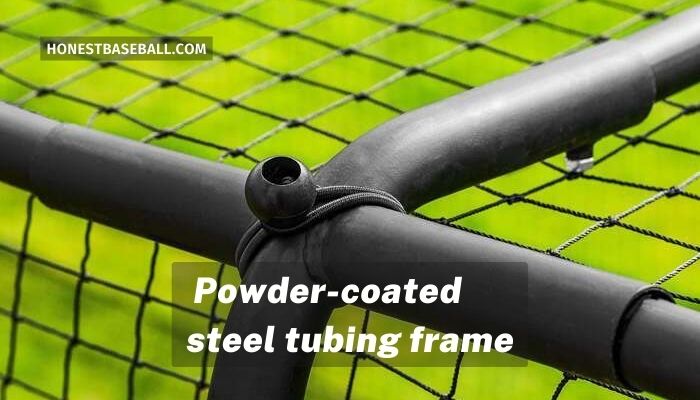
The most durable material utilized to construct baseball batting cages is steel. The most important truth is that steel endures the worst weather and conditions for an extended period of time.
The longest lasting of these three, it can grip and resist the heaviest line drives. Another reality is that steel frames cost twice as much as fiberglass cages due to their strength and durability.
However, I wager that you won’t regret the price once you own a set of steel frame batting cages. On the other hand, steel frames need more work to install since they are often permanent cages that must be anchored into the ground.
To install a brand-new batting cage, you need the necessary tools. Additionally, it takes longer to install steel cages than fiberglass poles.
Steel frames provide the strongest grip against strong winds, in contrast to other types of frames. But sometimes the strongest storm can knock them out. However, if you can set up the steel rods in the ground with the greatest amount of strength, they will even retain the ground firmly.
Although steel batting cages provide many benefits, there are some drawbacks as well.
Steel batting cages cost more than any other batting cage on the market, in addition to enhancing strength and longevity. Additionally, it has greater delivery fees.
The process of installation of steel cages is more time-consuming and hardworking. You need to cement them into the ground correctly. Even if you use temporary batting cages made of steel, they will need more than 1 hour to set up and remove.
Difference Between Short Tunnel and Long Tunnel
Many people think the long tunnel for the batting cages is the only good option. But things to consider while choosing the tunnel length.
Several entities should determine the length of the batting cages. Age and level of the players, player’s height, level of development, etc., all must be taken into account to determine the length of the batting cages’ tunnel.
Short Tunnel
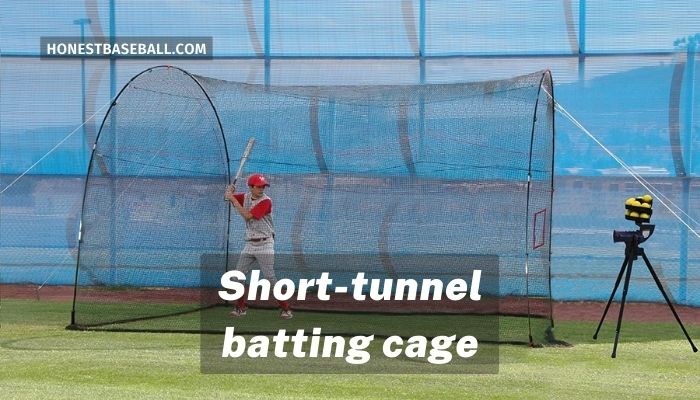
The short tunnel’s most significant and noticeable benefit is it occupies less space. This is a great option for you if you have no additional space to give up the batting cages.
On the other hand, short tunnels save a significant amount of money compared to long tunnels. So, the short tunnel would be the best batting cage if you are thinking about the budget.
On the other hand, a short tunnel is preferable for the younger players, especially players who play below the high school level. On the other hand, if a professional and bigger player is inside a short tunnel, he will get less space to swing his bat.
Also, there is little time to analyze the ball that comes from the pitching machine or the live pitcher.
Long Tunnel
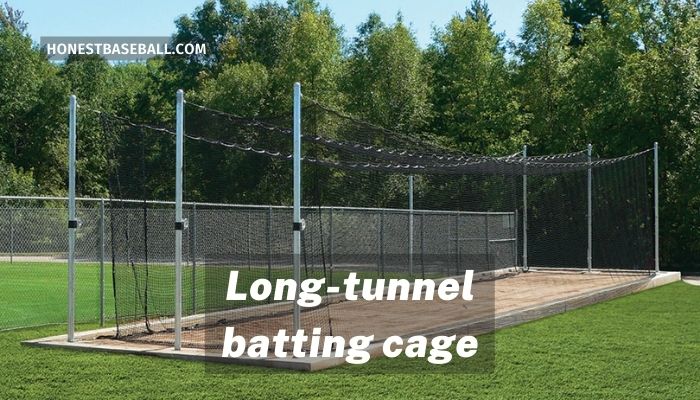
People are hyped with long tunnel cages. But, this is the best option for professional and power-hitting players. As I have mentioned before, a long tunnel that ranges from 66 to 70 feet is likely to be the same as the real length of the baseball home plate to the pitching mound.
As a result, the batter can develop real-time hitting mechanics from the actual distance he will play on the battlefield.
A long tunnel also will pay off for the younger players in the future if they withstand it from the beginning. On the other hand, a long tunnel allows room for wide swinging, equipment storage, pitching machine placement, safe distance for the live pitchers, and so on.
The big advantage is the batter can properly analyze the coming pitches in a long tunnel due to more space.
By the way, the long tunnel also has a drawback. It is expectedly costlier than the short tunnel. This could be an issue for the budget.
But, if there are no space and budget issues, I recommend taking a long batting cage. It will let you not regret it in the future for sure in terms of developing your batting mechanics. The standard 70 feet batting cages should be on the list.
Differences Between Buying a Batting Cage Kit and a Complete Batting Cage
It is true that you will certainly get more advantages from a complete set of batting cage. Because you will get everything needed in the one place, and not be bothered with any spare parts.
Also, it can be relieved by buying only the necessary products, not excessive parts.
But in all means, purchasing a complete batting cage material is more expensive than buying them separately. A steel batting cage costs more than a steel batting cage kits.
By the way, this might happen due to shipping costs. People may hear “free” shipping. Actually, nothing is free in this world. You must pay for your service. Probably in a different way.
Like the merchant would keep and include the shipping charge to the price of the cages.
By the way, it’s up to you what you will choose. You may buy a complete batting cage that is heavy and costly to ship. But get them completely and no hassle for searching and getting the other parts for different places.
On the other hand, you might go for the steel poles and install your own batting cage by yourself. This will increase your work but will decrease the cost significantly.
5 Best Home Batting Cage to Consider Buying
| No. | Product Name | Recommendation |
| 1 | Net World Sports Fortress Ultimate Batting Cage | Best Overall |
| 2 | Heater Sports Xtender Batting Cages 24 feet to 72 feet | Reliable One |
| 3 | Skywalker Sports 40 Foot Competitive Baseball and Softball Batting Cage, Collapsible Frame & Net | Lightweight |
| 4 | Fortress Trapezoid Baseball Batting Cage | Complete Package |
| 5 | Fortress Mobile Baseball Batting Cage | The Most Expensive One |
1. Net World Sports Fortress Ultimate Batting Cage (Best Overall)
Net World Sports is one of the reliable and friendly brands that make home batting cages of different lengths. You will find batting cages from 20 feet to 70 from the Net World Sports.
By the way, depending on your backyard area, you may choose anything from 20 feet to 70 feet long Fortress Ultimate batting cage. This commercial batting cage frame is constructed of steel rods and materials.
The 40mm-diameter amazingly durable steel poles are created. The steel poles have been powder coated and galvanized. This guarantees that there will be no corrosion or deterioration.
On the other hand, commercial netting material #42 grade is used. This withstands the heavy powerful hits by the hitters. The 48 mm mesh is protected from the ultraviolet rays of the sun. Also, it is highly rot-proof and allows you to leave it outside without any mess.
The 2 mm netting is highly reliable and easy to cover up the steel frame in minutes. It is a one-piece design net that doesn’t give you any hassle.
By the way, this particular model of the Net World Sports is found in 4 different sizes: 20 feet, 35 feet, 55 feet, and 70 feet. 4 poles feature 20 feet, 35 feet is 6 poles, 55 feet is 8 poles, and 70 feet is 10 poles.
You can use the Fortress Ultimate Batting Cage in the field and in your backyard.
Pros
- The one-piece net is easy to assemble.
- Steel construction gives super durability.
- The braided rope edges are strong enough and rot-proof.
- Different size batting cages are available to choose from.
Cons
- The price is a little high as this one is one of the high-quality batting cages.
2. Heater Sports Xtender Batting Cages 24 feet to 72 feet (Reliable One)
The Heater Sports pitching machine is included with the Sandlot 4-in-1 batting cage. The fiberglass frame is made of 3/8 inches thick which is flexible and durable. 1 3/4 poly netting is as reliable as the frame.
The batting cage’s fiberglass rods directly into the ground stakes. Along with it, the nylon support rope is here to extend the support for the frame stance. There is a built-in pitching machine harness with this cage.
This 18-inch long tunnel cage allows 40 mph pitches, which is enough for the kids to practice.
The heater sports pitching machines have tubular steel legs, adjustable pitch height, and rubber tips. The power uses standard A/C power. The simple On/OFF switch is easy to operate the machine.
The dimension of the cache is 18 x 11 x 8′ (L x W x H). It is recommended for players aged 4 to 12 years old.
Pros
- Complete batting cage set which is reliable for kids.
- The assembling process is easy and the removal process is as well.
- 40 mph is a good speed to practice for the kids.
- The age also comes with a pitching machine harness that eases the placement of the pitching machine.
Cons
- The batting cage set is not as durable as it is designed for kids with fiberglass.
3. Skywalker Sports 40 Foot Competitive Baseball and Softball Batting Cage, Collapsible Frame & Net (Lightweight)
This 40-inch cage is a good option if you’re worried about space in your backyard but still want a professional-level batting cage. It saves space in your yard and offers an adequate area for batting practice.
The 40-foot tunnel is ideal for usage at home since it positions the cage correctly. Continuing to practice might be a great option for players of all skill levels.
You can move, set up, and transfer it easily thanks to the frame’s lightweight and foldable design. It weighs less than 100 pounds, making it one of Skywalker’s lighted batting cages.
It is incredible that the batting cage’s structure is built of steel rods while being so light. Corrosion is avoided by the powder coating on the steel tube.
Additionally, the cage’s net material is UV-protected and can take stronger blows from players with more experience.
The cage will be delivered to you in 4 different boxes. The company provides the anchors needed to hold the batting cage up in the face of strong winds. The fantastic thing is that you can hold and stabilize the cage without any rope or wires.
Pros
- The free-standing cage allows for quick assembly and the portability allows easy transportation.
- Steel-made frame but lightweight.
- Powder-coated steel is safe from corrosion.
- The full package is value for money.
- You must be comfortable with solo batting practices.
Cons
- The lightweight might become an issue of sturdiness.
4. Fortress Trapezoid Baseball Batting Cage (Complete Package)
A great choice for a batting cage that is found in 3 different sizes: 35 feet, 55 feet, and 70 feet. Also, found both internal and external netting.
The steel frame is galvanized, which is waterproof and rust-proof. The 40mm steel frame is also powder-coated, making it invisible from corroding.
#42 weatherproof netting is used which is 1/4 inches thick. The netting is rot-proof and rope-edged. The great fact is, that you can choose both internal and external netting for covering up the frame.
Another great fact is that there is no need for anchoring the poles of the cage into ground stakes. The free-standing frame stands its own, even with no need for additional ropes or wire.
So, the portability makes it a great choice for school, college, home, and professional batting practice. Ultimately, the cage holds a heavier stance that allows you heavy-duty struck and fastest pitches practices.
Pros
- Galvanized steel is weatherproof and gives longevity to the batting cage.
- The powder-coated frame is corrosion-proof.
- Found in different sizes.
Cons
- As the frame is not anchored, the free-standing design might not be that powerful against heavy wind.
5. Fortress Mobile Baseball Batting Cage (The Most Expensive One)
The first thing to talk about this mobile baseball batting cage is that it is the most expensive one on our list. Another unique feature is that it is portable and powered by heavy-duty anti-tamper wheels.
So, you can move the cage on its wheel on any type of playing ground including your yard.
By the way, the cage is found in two different variants: 24 feet long and 36 feet long. The 24 feet one is powered by 6 wheels, whereas the 36 feet one is powered by 8 wheels.
The cage is entirely free-stand, with no anchoring, having 2.5mm galvanized steel. The galvanized steel is weatherproof including water, rust, and corrosion.
The net of the cage is crafted with premium 2mm HDPP netting. In this netting, you will get 48mm mesh that is highly withstandable to powerful hit impact.
The net is completely protected from UV rays and damage from excessive sun heat.
The padding for weather circumstances makes the cage durable for years, protecting it from ill-disposed weather. The exclusively used premium-grade materials make this baseball batting cage beyond premium.
Pros
- Using premium-grade materials brings more durability.
- Highly quality netting is protected from weather and UV rays.
- Portability allows moving the cage anywhere in the playground or your yard.
- The padding ensures extra protection against the weather.
Cons
- The only drawback is its price. It is too pricey to get one.
Frequently Asked Questions
How much does it cost to build a batting cage at home?
The cost of the batting cages varies from factor to factor. You might find a smaller cage for around $200. This might be raised up to $2000 based on the size and quality.
On the other hand, if you want to permanently install a batting cage in your backyard, this might cost you around $1000 to $2500. It all depends on the circumstances, materials, types of cage, etc.
How much space do I need for a home batting cage?
A home batting cage could be 15 feet to 80 feet long. So, you have to consider the area you want to put on your cage depending on the length of the cage. You must also keep some additional room to properly set the cage up.
By the way, keep the utmost caution while setting up the cage. Make sure the cage doesn’t collide with the electrical poles and wires.
Is a 35-foot batting cage big enough?
Baseball players of any age and ability level can benefit from the tunnel length of 35 to 50 feet, even though lengthy batting cages are recommended. Drills may be performed in small places in a variety of ways.
So, if you want to practice hitting, you may choose a 35-foot tunnel.
Are 10 feet wide enough for a batting cage?
Actually, this width is too compact for adults and professionals. Though kids could use this, minimum width of 12 feet is recommended. But in a more advanced way, we recommend a 14 feet wide batting cage.
Wrapping Up
Practice makes a man perfect. Nothing can make you master but practice by any means. In baseball, any type of skill needs extensive practice including batting, pitching, and so on.
The best home batting cage can help you to craft your batting skill and mechanics with time. On the other hand, you can even practice pitching with the batting cages which is a plus.
But, you should determine what you want and how to get the best batting cages. This post has discussed and explained getting the best batting cages with all the necessary information. I hope this will help you get your desired batting cage the easiest way.

Hello everyone. My name is Jason Butler, and I live in California, America. I was a professional AAA Minor League Baseball player. I lost my chance of playing MLB for injury issues, but I did not lose my love for baseball. I attended the coaching training program and am now working as a coach in a small school in San Diego.
I always love to share my experience and knowledge if that can help you. Play baseball, and stay fit.
